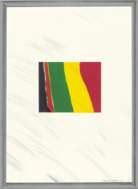
Picture Of A Pointless Abstraction Framed Under Glass

Picture Of A Pointless Abstraction Framed Under Glass
Signed Print
David Hockney
£2,100-£3,100
$4,200-$6,000 Value Indicator
$3,850-$5,500 Value Indicator
¥20,000-¥29,000 Value Indicator
€2,400-€3,550 Value Indicator
$22,000-$30,000 Value Indicator
¥440,000-¥640,000 Value Indicator
$2,800-$4,150 Value Indicator
There aren't enough data points on this work for a comprehensive result. Please speak to a specialist by making an enquiry.
76 x 56cm, Edition of 85, Lithograph
Auction Results

Track auction value trend
Meaning & Analysis
Picture Of A Pointless Abstraction Framed Under Glass is a signed lithograph dating from 1965. Hockney made the work as part of the portfolio A Hollywood Collection, a series of prints representing the fictional collection of a Hollywood movie star. Each print features a trompe l’oeil device, in the form of a frame, and in this case a piece of glass which the artist has carefully rendered with fine grey lines to give the impression of a reflective surface. The abstraction itself is made of bright planes of colour but while it lies at the centre of the composition, it feels like Hockney is more concerned with the effect of removal caused by the introduction of the trompe l’oeil frame. While this series comes at the beginning of Hockney's long career, and his relationship with LA printers Gemini Workshop, it shows his ongoing fascination with optics and perspective, and the enduring influence of the old masters who came before him. Here we see him overtly referencing an art historical device to create the ‘play within a play’ effect we see him achieve elsewhere with curtains and stage sets.